Scorpion Investigations, How do They Live?
My husband has a new job which takes him away from us during the week, because it is a six hour drive away. He currently doesn't have anywhere to live, so he's been camping in woodlands next to a river; one of the few free places to camp in the area. Last Friday he came home with a lump on his head, like a large mosquito bite and a scorpion in a tub. It seems that's what you get for camping in Australia with separate ground sheet, instead of a sealed tent!
Being a homeschooling family, we're not ones to miss a learning opportunity, so the first thing we did was try and find out what type of scorpion it was and what it needed to survive.
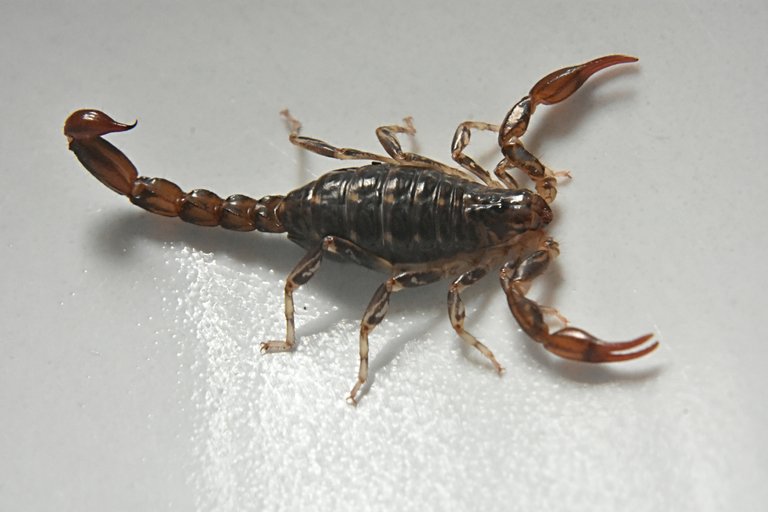
photo courtesy of @izzydawn
Identification
When it comes to scorpions Australia doesn't have any deadly ones, which is somewhat surprising for a country renowned for some of the deadliest creatures in the world and with a reputation for everything trying to kill you! By process of elimination, we figured out that Mosquito (as it is now been named) was either a type of marbled scorpion or a wood scorpion. Where it was found ruled out it being a desert or rainforest scorpion. In fact most scorpions are located in arid areas, so habitat was the quickest way to eliminate most possibilities, even if they were visibly similar looking.
The marbled scorpion is the most often encountered scorpion, because it can live in urban areas, but it's also found in gum forests, which would certainly have matched the surroundings of my husband's camp. While Mosquito’s patterning isn't very marbled, the legs seemed very similar, but the longer length of the pincers in the pictures of many of the marbled scorpions made me keep searching.
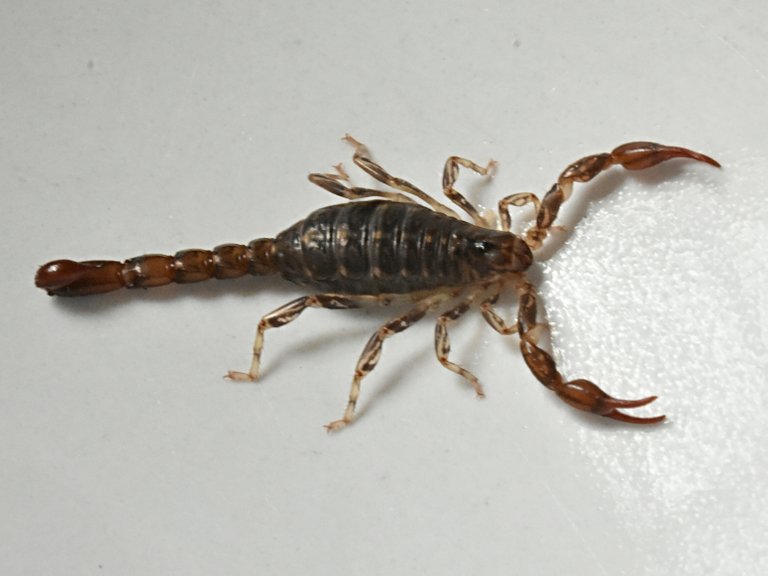
photo courtesy of @izzydawn
Further searching brought up the new candidate, the wood or forest scorpion. Not all the photos seemed to match Mosquito, but many of them did look very similar. Sizing range for both the marbled and the wood scorpion were about right; habitat was looking about right for where both came from so once again, it was location which made us think that maybe it was more likely the wood scorpion, because it looks like the marbled scorpion doesn't range where my husband was camping.
Scorpion Habitat and Diet
There is plenty of advice on caring for scorpions online, but some common sense was needed to figure out what was pertinent to this type of scorpion. The woodland scorpion apparently likes a habitat with high levels of moisture, which Mt. Gambier certainly provides with its high rainfall. It's the only scorpion to be found in Tasmania, so really quite well adapted to cooler climates. So a heating pad would not only be unnecessary, but probably unwise too. The ideal temperature range for this type is actually between 20°C and 30°C and outside of that they tend to burrow into the ground.
On the evening that my husband brought it home, the main concern was food and water. A quick search yielded the advice that rather than a bowl of water, keep the substrate damp and they will take moisture from there. Alternatively a ball of soaked cotton wool would provide them with what they need. They also eat insects and arachnids up to half their body size. So for that night I soaked a tissue in water and dropped that in the tub along with an earwig and a weevil collected from the garden.
The following morning Mosquito was under the tissue with the weevil and there were only the tougher remains of the earwig. Another hapless earwig that made its way into our house ended up in the tub while we figured out the best set up for Mosquito. We came back later to observe how scorpions make a laborious meal of their catches.
After stinging their prey to immobilise it, their mandibles chew their food into smaller pieces and mostly the soft parts are eaten. It takes time to chew through to those soft parts, however, so it's a slow process. I'm guessing this is why Mosquito had no interest in the armour plated weevil. It did enjoy a small cockroach later, though.
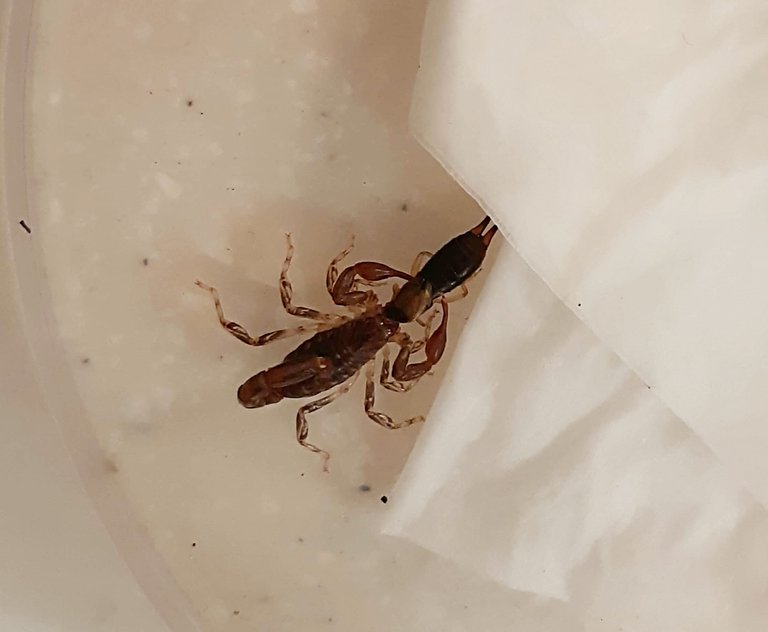
Moving on to the construction of the habitat, most of the pet scorpion advice caters to desert scorpions and the substrate would generally be sand for them. We thought mimicking a forest floor would be more suitable for woodland scorpion and did finally find advice on a set up more like that. We have lots of sawdust and wood shavings from firewood preparation, so we moistened some of that with a bit of soil for the bottom of the tub and found a piece of bark for Mosquito’s new daytime hiding place. Scorpions are nocturnal, so they hide during the day.
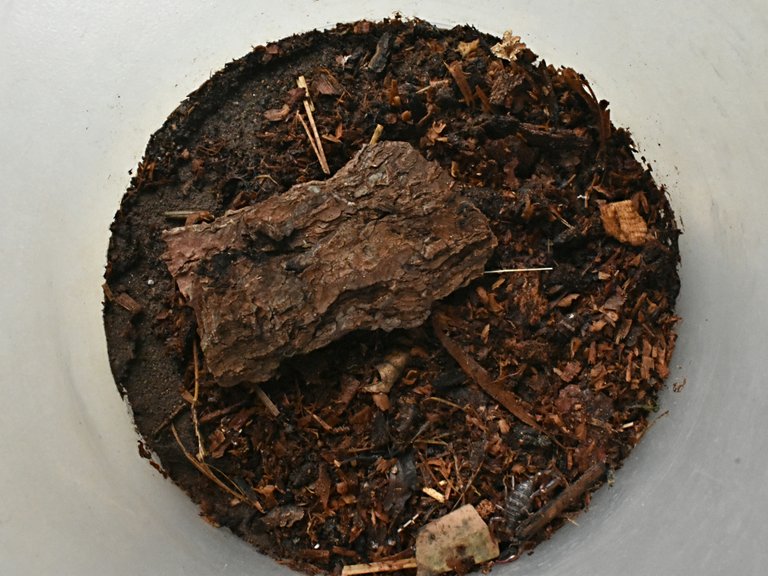
photo courtesy of @izzydawn
Mosquito blended into the substrate beautifully and it was a perfect environment for prey like earwigs too. If Mosquito wasn't hungry that night, then they could live off the detritus in the substrate. As it happens, they rarely last a night.
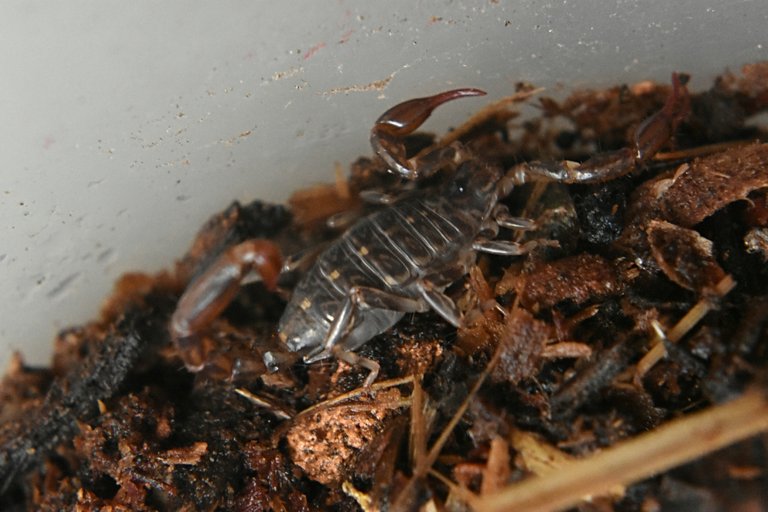
photo courtesy of @izzydawn
After further reading we discovered that scorpions supposedly only eat once or twice a week, yet this one eats daily. We're either going to have one fat scorpion soon, or the fact that it's adapted to cooler climates means that this particular type does need to eat more frequently.
Scorpions can live for over 5 years, but I don't think we'll keep Mosquito for that long. As cute as it is, I know interest will be lost in it and we'll probably look at finding a nice woodland area to release it, or maybe send it back to Mt Gambier. There have been suggestions of feeding it to the chickens, but I don't think I can bring myself to do that.
Could mosquito be used in the garden to help fight against other pests? :)
Great post!
The thought had crossed my mind. I don't know if the areas that mimic it's habitat would be established enough for it to survive, though. It's still very open and I struggle to keep the ground damp.
Very interesting research and putting what you learned into practice. I didn't really grasp the size of Mosquito from the last post, but he's less than half the size of adult Wood Scorpions from Southern Oregon that I have seen, as they reach a couple inches in length.
I hope that if you do release Mosquito back into the wild, you do so back where you found him.
Thanks!
I did think it will be better adjusted to the area it came from in the first place. It's a bit too dry where we are.
Wow, I'm impressed @minismallholding that you can find anything attractive about scorpions. The only place we ever lived, where a "close encounter" with these was even a remote possibility, was the Sonora Desert of southern Arizona. And they were all around us. I remember reading about people using certain types of lights to find them at night ...
While there, I attended a presentation where we were told three-fourths of everything "out there" was poisonous to one degree or another. Seemed to be what was required for survival in that god-forsaken country. Sounds like parts of Australia are similar perhaps.
Thankfully, we only lived there for less than 3 years. Not for us ... We move north and found living ~ 100 miles from Canada much nicer than living ~ 100 miles from Mexico ... 😊 Not so coincidentally, we learned there that no known poisonous creatures of any kind existed, not even rattlesnakes, except for a very rare spider of some sort ... Much better! 👌
Haha! Yes, heat seems to evolve deadliness! I'm from England, originally, where very little in the animal kingdom is venomous. South Australia isn't too bad. We have less deadly creatures than some of the other states. I see beauty in most things, but some need a lot more respect. This little guy is so small (we have spiders WAY bigger), I think that's what makes it cute. It's like those tiny little spiders who try and make themselves look big and fierce when you go near them, but they just look cute! 🤣
I'm still somewhat puzzled as to why hubby brought it home, was he specifically thinking it would be a good educational opportunity? XD
I think given all the other deadly things we have here maybe the scorpions couldn't compete (got eaten by the snakes or something?) XD
I don't think he would have specifically been thinking of the educational opportunity, but he does have this fascination with creatures, particularly unusual ones and probably wanted to share his experience. This was small enough of an encounter to bring back, we just get tales about the possums, wombat, the roo that ran into the side of his Ute and the panther that crossed the road (yes, panther, and there have apparently been other sightings in the area). He offered to bring a baby brown snake back next time, but I asked him to please not!! 😨
Wouldn't surprise me if they were snake food, for at least some snakes. Also wouldn't surprise me if the bigger spiders ate them too. Now, if it had been a spider, or any other big really, there is no way he'd have allowed it near him long enough for the journey home.
I don't know if I would have brought a scorpion home, but I found it fascinating reading about the differences of each if the types.
He can't help himself when he finds something exciting. Any other bug would have been kept as far away from him as possible. Except maybe a mantis, but we already get them here anyway.
Ouch!..